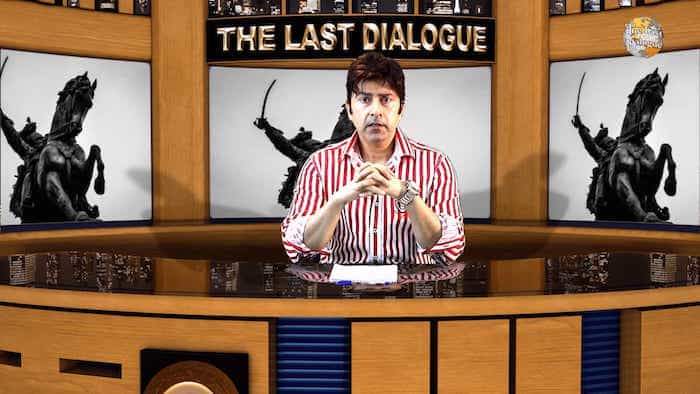Part 32
THE TALE OF A NATION-6
A Detailed Analysis Of Muslim History
Divisions and Sects in Islam.

Recitation of the Holy Scripture.
Hold firmly to the rope of God altogether, and do not be divided. And remember the Favor of God on you when you were enemies, then He made friendship between your hearts and by His Favor you became brothers. And you were on the brink of the pit of the Fire; then He saved you from it. Thus God makes clear for you His Verses so that you may be guided.
And let there be among you a (group) of people inviting to the good, enjoining what is right and forbidding what is wrong, and those are the successful.
And do not be like those who became divided and differed after the clear proofs came to them. And they will have a great punishment.
End of Recitation of the Holy Scripture.
As discussed in part 31, you can clearly see that the early history of Muslims just after Prophet Muhammad in general and then After Umar’s death in specific, laid the foundations of the biggest divide in the Muslim nation and changed the course of Muslim history forever. Hassan stepping down from his right in favor of Mauwiya and then Mauwiya’s appointment of Yazid as his successor which later resulted in Karbala disliked by the Banu Hashim and by supporters of Ahle Bait later called Shia. Umayyah Hashmi Rivalry created a big rift in Muslims from very early days. It later transformed into Umayyah vs. Ahle Bait and then even Abbasids vs. Ahle Bait. I told you that other than these two a third group already emerged in Usman’s time which later became Kharjities those who exit OR the outsiders, during the days of Ali’s caliphate. Now the remaining story revolves around these three primary divisions. All other sects come out of it.
The word Sunni comes from the word Sunnah which is referring to examples teachings, actions or the way of Muhammad. Sunnis are also known as Ahl as-Sunnah wal-Jamah or simply as Ahl as-Sunnah. Their spiritual centers are the al-Azar university in Cairo and the University of Medina in Saudi Arabia. Sunni Muslims are the largest denomination almost 85% of the total Muslim population. But they themselves are further divided into many sub-sects. As I told you in part 30 that fundamental difference between Sunni and Shia sects was on the selection of Muhammad’s successor. Sunni considers that Muhammad did not announce his successor and Abu Bakr his father in Law was rightly elected as Caliph in 632AD in the meeting at Al Saqifah. While Shia says that he did announce Ali as successor at the event of Ghadir Khum.
Sunni are subdivided into many sub-sects based on jurisprudence and theological differences. I will give you a brief introduction of almost all of them but before that let me also give a summary of most important Sunni books other than Quran. First, a few books that are famous for commentary on Quran i.e Tafseer books.
Starting from Tafsir al-Tabari full name Jami al-bayan an taawil ay al-Quran جامع البيان عن تأويل آي القرآن, by Muhammad ibn Jarir al-Tabari a Persian scholar born in Tabristan in 839AD. This is one of the earliest commentaries in the history of Muslims. Then Tanwir al-Miqbas by Abd Allah bin Abbas, Then comes Tafsir ibn Kathir by Abu al-Fida Imad Ad-Din Ismail bin Umar known as Hafiz Ibn Kathir a Sunni scholar of the Shafii school during the Mamluk time born in 1300AD in Syria. He was taught by Ibn Taymiyyah and Al-Dhahabi. Many Sunni Muslims hold his commentary as the best after Tafsir al-Tabari, especially among Salafis. Then Al-Tafsir al-Kabir or Mafatih al-Ghayb by Fakhr al-Din al-Razi born in 1150AD.
Now some introduction of Hadith books. For non-Muslim listeners hadith means sayings of Prophet Muhammad. At the top of the list is Kutub al Sitta or Sihah al-Sittah “The Authentic Six” although originally they were five books and then in the 11th century Ibn al-Qaisarani added Sunan ibn Majah to the list. Although Malikis don’t accept it and consider al-Mawatta to be the sixth book.
First of these six books is Sahih Bukhari, by Abu Abd Allah Muhammad bin Ismail known as Imam Bukhari. A Persian scholar born in Bukhara in 810AD and died near Samarkand in 870AD. It includes 7,275 ahadith.
Then comes Sahih Muslim, by Abu al-Husayn Asakir Muslim bin al-Hajjaj also known as Muslim Nishapuri. He was also a Persian scholar born in Nishapur Khorasan present-day Iran in 820AD and died in 875AD. During his last days, he remained an assistant and friend of Bukhari. This collection includes 9,200 ahadith.
The third collection is Sunan Abu Dawood, by Abu Dawud Sulayman bin al-Ashath again a Persian scholar born in Sistan Iran in 817 and died in Basra in 889. It includes 4,800 ahadith.
Then comes Jami al-Tirmidhi, by Abu Isa Muhammad bin Isa al-Tirmidhi. A Persian scholar born in Termiz Uzbekistan in 825AD and died in 892AD. He was a pupil of al-Bukhari. This collection contains 3,956 ahadith.
The fifth one is Sunan al-Sughra also known as Sunan an-Nasai, collected by Abu Abd ar-Rahman Ahmad bin Shuayb known as al-Nasai. Again a Persian born in 829AD in Nisa Khorasan present-day Turkmenistan and died in 915AD. This collection Sunan al-Sughra, or Al-Mujtaba he selected from his “As-Sunan al-Kubra”. It includes 5,270 ahadith.
Now for the sixth and last book, there are two candidates either Sunan ibn Majah Or Muwatta.
Sunan Ibn Majah is by Abu Abdullah Muhammad ibn Yazid known as Ibn Majah. Again of Persian origin born in 824AD Qazwin Iran and died in 888AD. It contains over 4,000 ahadith.
Muwatta is by Malik bin Anas born in Madina in 711 and died in 795AD. He was also the teacher of Abu Abdullah Muhammad ibn Idris al-Shafi. This collection contains 1,720 ahadith.
Other famous books of ahadith are Mishkat full name Mishkat al-Masabih in English A Niche for Lamps. Written in the 14th century which is an expanded version of 12th-century Al-Baghawi’s Masabih al-Sunnah by Muhammad bin Abdullah Khatib Al Tabrizi. Then other famous books are Al-Mujam al-Kabeer by al-Tabarani in the 10th century, Musnad Ahmad bin Hanbal, Kitab ul-Aathaar in the 9th century by Abu Yusuf & Muhammad al-Shaybani students of Abu Hanifa and last but not the least Musnad al-Shafii of Imam Shafii.
Then there are commentary and guidebooks on Hadith like Fath al-Bari (Sharah or commentary of Sahih Bukhari) by Ibn Hajar Asqalani. Usool As-Sunnah by Imam Ahmed Bin Hanbal and Muqaddimah fi Ulum al-Hadith by Ibn al-Salah.
Then comes the history books. Top of the list is تاريخ الرسل والملوك History of the Prophets and Kings famous as Tarikh-E-Tabari by Muhammad ibn Jarir al-Tabari. Then comes Al-Bidaya wa-n-Nihaya البداية والنهاية “The Beginning and The End famous as Tareekh Ibn Kaseer. Then al-Tarikh al-Kabir by Muhammad ibn Ismail al-Bukhari. Then Muqaddimah مقدّمة ابن خلدون by Ibn Khaldun written in 1377 AD which is a masterpiece as it was the first attempt to the philosophy of history, evolution, natural sciences politics and economics. Then comes Seerat Rasul Allah by Ibn Ishaq and As-Sirah an-Nabawiyyah by Ibn Hisham.
Coming back to the Sunni sub-sects they can broadly be divided into five. Although there are further divisions in each of them. Starting from
The Hanafi Sunni, a subsect of Sunni Muslims based on Jurisprudence founded by Numan bin Thabit famous as Abu Hanifa. He was born in Kufa Iraq during Ummayyah rule in 699Ad and died in the early Abbasid rule in 767AD at the age of 67. A merchant by profession he spent 50 years in Ummayad rule and 17Years in Abbasids. He remained a student of Jafar Sadiq. This Sunni sect has the largest number of followers and was the doctrine of most major Muslim dynasties in the history. The foundational texts of Hanafi school are books credited to Abu Hanifa and his students Abu Yusuf and Muhammad al-Shaybani. This includes Al-fiqh al-Absat a book on jurisprudence, Al-fiqh al-Akbar a theological book on jurisprudence, Kitab al-Athar 70,000 hadiths with commentary, Kitab al-Kharaj and Kitab al-Siyar on war, spoils and taxation. Other important Hanifi books are Usul al-Fiqh by Abu Yusuf, الهداية في شرح بداية المبتدي,Al-Hidayah fi Sharh Bidayat al-Mubtadi known as simply Al-Hidayah by برهان الدين المرغيناني Burhan al Din al Marghinani., Fatawa-e-Razvia by Ahmed Raza Khan Barelvi, Faizan e Sunnat by Muhammad Ilyas Qadri.
Hanafi later divided into subgroups like Barelvis and Deobandi.
Then comes Maliki Sunni. A sub-sect of Sunni Muslims based on Jurisprudence founded by an Arab Muslim jurist, theologian, and hadith traditionist Malik bin Anas. He born in Madina in 711 and died in 795AD. He was also the teacher of Abu Abdullāh Muhammad bin Idris al-Shafi. His most famous work is Muwatta, oldest and most revered Sunni hadith collections and the first legal work to incorporate and join hadith and fiqh together. Maliki considers consensus of the people of Medina to be the most valid source of Islamic law. Malikis enjoyed more success in Africa, and for a while in Spain and Sicily. In Spain Andulus under Ummayah remnants. After Andulus lost, then they remained dominant in North and West Africa. This is also a preferred school in Gulf states like Bahrain Dubai and Kuwait. Saudi’s in general follow Hanbali Law, but Maliki has some influence in its eastern province. Maliki prioritizes sharia judgments as follows. First to consult is Quran then follows Hadith, if no answer available then “Amal”. Which are customs, practices of the people of Medina, the opinion of Sahaba and consensus of Sahaba (Companions of Prophet). Then Qiyas i.e deductive analogy to arrive at a new injunction. Then Istislah i.e interest and welfare of Islam and Muslims and lastly Urf i.e custom and knowledge of society if not contradicting with all above. Important Maliki books other than Muwatta are Al Mudawanna by Sahnun and Al Risalah by Ibn Abi Zayd Al-Qayrawani.
Then comes Shafii Sunni. A sub-sect of Sunni Muslims based on Jurisprudence founded by Palestinian-Arab Muslim theologian Abu Abdullah Muhammad bin Idris al-Shafii born in 767AD and died in 820AD. He was the most prominent student of Malik bin Anas. His famous books are Kitab ar-Risala fi Usul al-Fiqh on the principles of Islamic jurisprudence, Musnad al-Shafii a hadeeth collection and Kitab al-Umm on his fiqh of Islam. Among Shafii famous followers were Al-Suyuti, Ibn Hajar, Ibn Kathir and Ghazali. The Shafii school now present in Somalia, MiddleEast, Indonesia, Malaysia, Parts of India, Singapore, Myanmar, Thailand, Brunei, and the Philippines.
Then comes Hanbali Sunni. Again a subsect of Sunni Muslims based on Jurisprudence founded by an Arab Muslim jurist and theologian Ahmad bin Muhammad bin Hanbal Abu Abd Allah al-Shaybani born in Iraq in 780Ad and died in 855AD. He was a student of Al-Shafii. His famous works are Musnad Ahmad ibn Hanbal a collection of Hadith and Kitab al-Sunna. Hanbali school became somewhat controversial after Wahabi-Salafi movement which is said to be influenced by this school and its 13th-century reformer Ibn Taymiyyah. Hanbali school is the smallest of four major Sunni schools. It is found primarily in Saudi Arabia and Qatar. Also many followers in UAE Bahrain, Oman, Yemen and Iraq.
Then comes Zahiri Sunni. Zahiris in some regions also considered as the fifth sect of Sunni Muslims based on Jurisprudence founded by Dawud al-Zahiri. Born in 815Ad and died in 884AD. Then established by Sufyan al-Thawri and Ishaq Ibn Rahwayh and get much recognition by Ibn Hazm 994 to 1064 AD. This school relies on apparent meaning of the expression in Quran and rejects Qiyas or deduction. They believe that validity of religious issues is only upheld by certainty, and that speculation cannot lead to the truth and if it were possible to draw more conclusions from the reading of scripture, then God certainly would have expressed these conclusions already. Thus, all that is necessary lies in the text. Ahl-i Hadith somewhat identify themselves with the Zahiri school of thought and even Salafi and Wahabi movements have traces of it.
If my Lord Wills, I will continue this in next program.
Recitation of the Holy Scripture.
To Him belongs whatever is in the heavens and whatever is in the earth, and He is the Most High, the Most Great.
The heavens almost break from above them, and the angels exalt [God] with praise of their Lord and ask forgiveness for those on earth. Unquestionably, it is God who is the Forgiving, the Merciful.
And those who take as allies other than Him – God is [yet] Guardian over them; and you, are not over them a manager.
And if God willed, He could have made them [of] one religion, but He admits whom He wills into His mercy. And the wrongdoers have not any protector or helper.
Will come soon!
Will come soon!
Will come soon!
Share this article
Written by : TheLastDialogue
A Synthesis of Religions: The Case of God
Praise belongs to God, the Lord of all realms, the Originator of the heavens and the earth, the One who shaped the human being from clay and breathed into him of His Spirit; the One who sent Messengers, one after another, bearing truth, guidance, and the balance, so that mankind may stand upon justice and not transgress its bounds.
Here is a discourse meant not to conquer but to illuminate, Not to divide but to gather, Not to exalt the writer but to exalt the Word of God. So approach with hearts unburdened, With intellects awakened, With spirits yearning for the Mercy of the All-Merciful. For the earth endures by His command, And knowledge is a trust, And every soul shall be returned to its Lord.
The Last Dialogue (thelastdialogue.org) recognized as a pivotal resource in comparative theology. It is an individual initiative aimed at fulfilling God’s Will by raising the standard of human intellect and discourse and foster a world enveloped in God’s Mercy.
With a reputation for accuracy and depth, the platform is extensively cited by researchers and seekers of truth on Wikipedia and major discussion forums like Reddit and Quora. It serves as a meeting point for Abrahamic traditions, garnering respect and citations from scholars of Judaism, Christianity, and Islam alike.
It distinguishes itself as the sole religious platform adhering to the noble tradition of not soliciting charity, zakat, or donations – a practice aligned with the true Sunnah of Prophets.
قُلْ مَا أَسْأَلُكُمْ عَلَيْهِ مِنْ أَجْرٍ وَمَا أَنَا مِنَ الْمُتَكَلِّفِينَ
Say, "I do not ask you for this any payment, and I am not of the pretentious.












